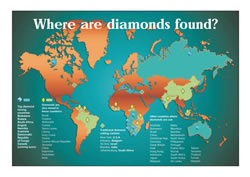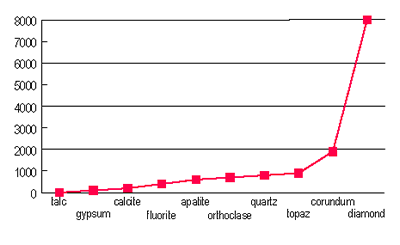Diamonds — General Information
Discovery & Mining
About 800 B.C., diamonds were found in the gravel and streambeds of India. By the 17th century, India's diamond reserves began to run out. In about 1725, prospectors searching for gold in Brazil, discovered diamonds instead. By the late 19th century, these mines, too, began to run out.
In 1866, the son of a Boer farmer living on the banks of the Vaal River brought home an unusual pebble. Intrigued by the stone, a neighbor bought it. That stone, the 21-carat Eureka diamond, was sold in Paris for $2,500. Today it shines from a gavel used by the premier of South Africa.
Diamond diggers, working the stream beds of the Vaal and Orange Rivers and fanning out across the countryside in search of other diamonds, found them in riverbed patches of yellowish earth. Below the yellowish, diamond-bearing layer, they found subsurface ore that yeilded more diamonds in a soft, mottled, green to blue-gray rock. These deposits were located in circular pipelike openings that funneled down several hundred feet. These pipes turned out to be the mouths of long-extinct volcanoes. The area became the site of the Kimberley mines, and the blue diamond-bearing ore is known as "kimberlite" or "blue ground."
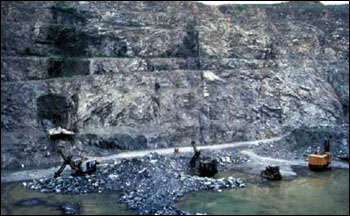
About 23 tons of blue ground must be moved to find one carat of diamond. This does not necessarily mean a single one-carat diamond, but several smaller stones that together weigh about a carat. All other qualities being equal, a two-carat diamond has more than twice the value of a one-carat diamond because larger diamonds are more rare.
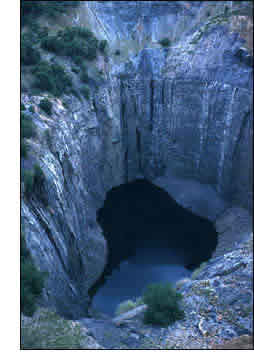 One
of the mines at Kimberley, known as the "big hole," was worked to
a depth of 3,520 feet. South Africa's Premier Mine, one of the largest in
the world, measured a mile across in one direction and half a mile in the
other. Today the world's largest mine is the Argyle, in Australia, though
most of its production is industrial and low-grade stones, known as "near
gem" quality. High grade, gem quality, diamonds are found primarily in South
Africa and Russia.
One
of the mines at Kimberley, known as the "big hole," was worked to
a depth of 3,520 feet. South Africa's Premier Mine, one of the largest in
the world, measured a mile across in one direction and half a mile in the
other. Today the world's largest mine is the Argyle, in Australia, though
most of its production is industrial and low-grade stones, known as "near
gem" quality. High grade, gem quality, diamonds are found primarily in South
Africa and Russia.
Where Are Diamonds Found?
(click for larger image)
Prior to this century, owning a diamond was reserved for the wealthy. Today diamond engagement rings are found in a majority of American households. This is partly because improved mining techniques have made diamonds more available and brought down their price. But the main reason is that a demand for diamonds was created, largely by the De Beers organizations and their worldwide advertising. The diamond engagement ring and the slogan "A diamond is forever" were both created by the De Beers marketing arm, N.W. Ayer and The Diamond Promotion Service.
Diamond Attributes
Hardness
Hardness scale
Diamond is the hardest gemstone known. It rates a 10, the highest grade, on the Mohs scale of hardness. (Talc, the softest mineral, is 1 on the Mohs scale.)
Hardness means the ability to resist scratching. All gems can scratch stones that are softer, or lower on the hardness scale. Nothing can scratch diamond except another diamond. In cutting and faceting diamonds, the cuts and the polishing must be made with diamond.
Diamond's hardness also means it is able to take a high polish.
Toughness
Toughness refers to the ability of the gem to resist breakage, as from a blow or fall. Diamond's toughness rating is only fair to good. This means that the cut proportions are especially important. If the culet is too small, or if the girdle is too thin, the gem is more likely to chip.
 Buyer's
Tip
Buyer's
Tip
Never buy a diamond that has a girdle stated to be "very thin," "extremely thin," or "very thin to extremely thin." Such stones are very easily damaged and will require special handling.
The 4 Cs of Diamonds:
Cut Proportions
Carat Weight
Clarity
Color
Diamond Cutting
Diamond Treatments
The culet, the cut at the bottom of the diamond, is meant to flatten the point that would otherwise be vulnerable to chipping. If the culet is not present, or is too small, the stone will chip more easily.
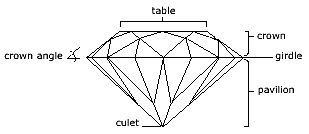
The girdle is where the setting holds the stone. If the girdle is too thin, the diamond will chip there. If the girdle is unevenly cut, the stone will be problematic to set.


